Garden and Bake Oven Recettes, 2010-2012
Fort de Chartres November Rendezvous, 3 Novembre, 2012
Saturday’s Bake Oven Recipes
Many of the recipes baked at the November Rendezvous have been published earlier on this page. The recettes for Little Plum Cakes, Common Seed Cake, Steamed Pumpkin Pudding, Pompkin Chips, (AH) and Prairie du Rocher Bread were published in October’s Demonstration of the Pierre Menard Home Summer Kitchen. The Corn Bread (CK) receipt is posted in recipes for the March 30, 3rd Annual School Day Event at Fort de Chartres. The following new recettes include the Fruit Tarts, Blackberry Jam, and Stuffed Custard Apples baked at the Rendezvous.
Stuffed Custard Apples
Modern
4 small to medium apples (I used Granny Smith Apples)
4 large eggs (separate the yolks in one bowl, the whites in another)
1 c. whipping cream
¼ c. sugar for cream
¼ c. sugar for covering the outside of the apples
¼ tsp of ground nutmeg
Lemon Zest from about 4 medium lemons
Cream Filling – Whip egg yolks, Combine the cream, whipped egg yolks, sugar and spices in a saucepan. Over medium heat, cook until thick enough to coat the spoon. Stir consistently as to not curdle the filling. When the custard is thick, set aside. You will want to use it when it is still warm.
Pare the apples and core the apples. Leave a portion of the core to make a cup to hold the cream.
Sprinkle lemon rinds inside and outside the apple.
Whip egg whites until they form stiff peaks.
Roll the apples in the egg whites.
Role the apples in the ¼ cup of sugar.
Place the apples in a pie plate or cake pan. Spoon filling into the holes of the apples until they are full. Bake the apples at 325° for 50 to 60 minutes. RD
Williamsburg site: http://recipes.history.org/2012/09/stuffed-apples/
– Dalrymple, George. “The Practice of Modern Cookery”
Core them as the last, and fill them with a good marrow cream; baste the outside with the whites of eggs, to make as much fine sugar stick to it as possible; bake them in a slow oven upon the dish you intend for the table and serve them hot or cold.
Renea’s notes: You will have to adjust the time based on the type of apples you are using. The harder the apple the longer it will take to cook. The apples will have some slight browning to them and a little soft. The filling will be brown on top.
Fruit Tarts
Crust – Royal Paste No 9 Amelia Simmons – American Cookery
1/2 pound flour
1/4 butter – slightly soft
2 egg whites
1 ounces sugar
Any jam, preserves, or custard – we used blackberry and citron jam and pumpkin custard
Rub flour and butter together until crumbles.
In a separate bowl, whip egg whites until peaks are formed.
Add sugar to egg white mixture, whip again.
Combine egg white mixture to flour mixture until dough is made into balls. Do over mix.
Put dough in a cool place for a few minutes.
Roll dough out until thin as a pie crust
If you have tart pans –
Line pans with dough
Fill pans ¾ with jam or preserves
If you do not have tart pans –
After rolling dough out cut into small squares (about 1 ½ – 2 inches)
Place a small amount of jam or custard in the middle.
Fold square to make a triangle, pinch edges together.
If needed, lightly wet fingers to pinch edges if not staying together.
You can lightly brush the top of the tart with an egg white if you wish. RD
Blackberry Jam
To six quarts of ripe blackberries, allow three pounds of the best brown sugar. Mix the sugar with the fruit and mash all together, with the back of a spoon. Put into a preserving kettle and boil it two hours, stirring it frequently. When cold put it in a jar with brandy paper. In a dry place it will keep a year.
Receipts from the Days of Old Kaskaskia CK
Other fillings used in Renea’s tarts: Citron melon preserves (posted in this past Pierre Menard Celebration recipes) and an improvised Pumpkin Custard. Extra cooked pumpkin pulp was combined with heavy cream, sugar, nutmeg and a generous measure of brandy. Thank you to Christine Hand who assisted in this creation. CK
Fort de Chartres October Heirloom Produce Saturday
13 October, 2012
We celebrate the bountiful crop of Pecans, Pumpkins, and Citron Melons this fall in the Illinois country and in the Jardin Potager, with the following 18th century recipes:
To make Pompion Chips
Shave your Pompion thin with a plain and cut it in slips about the width of your finger, put shreds of Lemon peal among it, wet your sugar with orange Juice and boil it into Syrup. Then put in your chips and lemon Peal and let them boil till done. The Receipt Book of Harriott Pinckney Horry, 1770
Steamed Pumpkin Pudding
6 tablespoon butter
3/4 cup brown sugar
1/4 cup granulated sugar
2 eggs
11/2 cups all-purpose flour
1/2 teaspoon salt
1/2 teaspoon baking soda
1/2 teaspoon ground cinnamon
1/2 teaspoon ground ginger
1/4 teaspoon ground nutmeg
3/4 cup mashed cooked pumpkin or canned pumpkin
1/2 cup buttermilk
Cream butter and sugar together until light. Beat in eggs. Stir together flour, salt, soda cinnamon, ginger, and nutmeg. Mix pumpkin and buttermilk; add to creamed mixture alternately with dry ingredients, mixing well after each addition. Spoon into greased and floured 6 1/2 cup ring mold. Cover tightly with foil. Bake 350 for one hour. Let stand 10 minutes. Unmold. Serve with whipped cream. Serves 12 to 16. http://www.handsonhistoryinc.org/HOH-Page11.html
Candied Citron Melon
Take some fine citron melons; pare, core, and cut them into long broad slices. Weigh them, and to every six pounds of melon allow six pounds of fine loaf-sugar; and the juice and yellow rind (pared off very thin) of four lemons; also, half a pound of race (root) ginger. Put the slices of melon into a preserving-kettle; cover them with strong alum water, and boil them half an hour, or longer, till they are quite clear and tender. Then drain them, lay them in a broad vessel of cold water, cover them and let them stand all night. Next morning, tie up the race ginger in a piece of thin muslin, and boil it in three pints of clear spring or pump water, till the water is highly flavored. Having broken up the sugar, put it into a clean preserving-kettle, and pour the ginger water over it. When the sugar is all melted, set it over the fire, add the lemon parings, and boil and skim it, till no more scum rises. Then take out the lemon peel, stir in the juice, and put in the citron slices. Boil them in the syrup till they are transparent and soft, but not till they break. When done, put the citron slices and syrup into a large tureen, set it in a dry, cool, dark place, and leave it uncovered for two or three days. Then put the slices carefully into wide-mouthed glass jars, and gently pour in the syrup. Lay inside the top of each jar a double white tissue paper cut exactly to fit, and close the jars carefully with corks and seal.
http://www.eattheweeds.com/citron-melons-abandoned-preserves-2/
Citron melon preserves:
3 quarts prepared citron melon
8 cups sugar, divided
2 quarts water
1 cup thinly sliced, seeded lemon
Cut the melon in half and remove meat and seeds. Then cut the rind in ¾ inch slices, removing the peel and discarding it. Cut the rind into 1-inch pieces. Remove the seeds from the meat and cut into about 1-inch pieces. Add 4 cups sugar to water and bring to a boil. Add citron chunks and cook rapidly until tender. Cover and let stand overnight.
The next day, add remaining sugar and lemon to mixture. Boil gently until melon is transparent and syrup is thickened. Stir frequently to avoid scorching. Remove from heat. Skim foam if desired. Ladle hot preserves into hot jars, leaving ¼ inch of headroom. Wipe jar rims clean and place hot, previously-simmered lid on jar and tighten ring down firmly. Process for 15 minutes in a boiling water bath canner. If syrup becomes too thick, add a bit of boiling water; if it is too thin and the citron is cooked and tender, remove the citron and continue boiling syrup until thick, then re-add citron.
Spiced Pecans or Walnuts
1 ½ cups pecans or walnut halves
½ white or brown sugar
¼ cup water
½ tablespoon grated orange rind
¼ teaspoon cinnamon
1/8 teaspoon ginger
1/8 tablespoon mace
Pinch of nutmeg
Combine all ingredients in a heavy skillet. Heat over medium temperature until the liquid boils. Stir constantly until all liquids have evaporated and nuts are coated with sugar. Spead on platter, separating nuts and allowing them to cool.
Similar recipes for spiced and sugared nuts contained in the Recettes of old Prairie du Rocher, Randolph County Historical Society, Receipts from the Days of Old Kaskaskia and Recipes of Old Saint Genevieve. CK
Please visit the garden and the bake oven during the fort’s Winter Rendezvous on Nov. 3 , for a garden tour and/or bake oven demonstration.
Demonstration of the
Pierre Menard Home Summer Kitchen
In honor of Pierre Menard
Born, October 7, 1766-Died, June 13, 1844
A celebratory birthday repast prepared featuring:
Tourtière, Beef a la Mode, Cucumbers to Stew, French Chicken Bouillon, Prairie du Rocher Bread, Common Biscuits, Lemon Puffs, Colonial Apple Cake, Sponge Cake, Spiced Pecans.
Tourtière (French Pork Pie)
2 pounds pork loin, diced into 1/2 inch pieces or ground
1 ¼ cup chopped onion
2/3 cup water
salt and pepper to taste
1 tsp cinnamon
¾ tsp ground cloves
¾ tsp ground nutmeg
1 Tbl flour
¼ cup cup water
Combine pork and onion in a skillet and brown. Add water, salt, pepper, cinnamon, cloves and nutmer and simmer for 20 min. Meanwhile stir flour and ¼ cup cold water until there are no lumps. When meat mixture is ready, stir in flour mixture, bring to boil and thicken.
Pease Porridge: Beond the King’s Bread, by JoAnn Demler, Old Fort Niagara Association. 2003 (Note: Cormier –Boudreau & Gallant p. 158
Using Royal Paste No. 9, previously posted in the October Recettes, roll on a well floured surface. Place into pie tin. Add meat mixture. Place top crust on carefully and make ½ inch slits to allow pie to vent. Brush with egg. Bake at 425 degrees for 10 minutes and then lower heat to 350 degrees. Bake 4o minutes or until crust is brown. This may also be served cold and topped with real maple syrup. RD
BEEF A LA MODE – 1769
FROM “THE EXPERIENCED ENGLISH HOUSEKEEPER” (1769) BY ELIZABETH RAFFALD
Take the Bone out of a Rump of Beef, lard the Top with Bacon,
then make a Force-meat of four ounces of Marrow, two heads of Garlick, the Crumbs of a Penny Loaf, a few sweet herbs chopped small, Nutmeg, Pepper and salt to your Taste
And the Yolks of four Eggs well beat, mix it up and stuff your Beef where the Bone came out
And in several Places in the lean part, skewer it round and bind it about with a Fillet
Put in a Pot with a pint of red Wine, and tie it down with strong Paper
Bake it in the Oven for three Hours
when it comes out, if you want to eat it hot, skim the Fat off the Gravy, and add half an Ounce of Morels, a Spoonful of pickled Mushrooms, thicken it with Flour and Butter
dish up your Beef and pour on the Gravy, lay round it Force-meat Balls and send it up.
Webster’s Dictionary defines ‘Force-meat’ as finely chopped and highly seasoned meat or fish that is either served alone or used as a stuffing.- called also ‘farce’.
Another
The beef ala mode (Amelia Simmons)
Notes: Red wine and water were used. Instead of stuffing it with 1 1/2 lb beef and sale pork, pork sausage was used instead. Placed the roast on several marrow bones to raise it from the bottom of the dutch oven. AH
To alamode a round of Beef
To a 14 or 16 pound round of beef, put one ounce salt-petre, 48 hours
after stuff it with the following: one and half pound beef, one pound
salt pork, two pound grated bread, chop all fine and rub in half pound
butter, salt, pepper and cayenne, summer savory, thyme; lay it on
scewers in a large pot, over 3 pints hot water (which it must
occasionally be supplied with,) the steam of which in 4 or 5 hours
will render the round tender if over a moderate fire; when tender,
take away the gravy and thicken with flour and butter, and boil, brown
the round with butter and flour, adding ketchup and wine to your
taste. AH
Cucumbers to Stew
Slice an equal quantity of cucumbers and onions and fry them together in buter [sic] strain them and put them into a gravy two spoonfuls [sic] of white wine and a blade of mace stew five or six minutes put in a piece [sic] of butter rolled in flour salt and cayenne pepper shake them well together till of a good thickness dish and serve them up
Harriett o’Fallon’s Cook Book from January, 1821
Missouri Historical Society CK
French Chicken and Bouillon
This soup was a staple in the Illinois country, noted by historians as common throughout the area. Traditionally the broth is served separately in cups and the chicken and vegetables served separately on a large plate.
Place 1 large fat hen (4-5 lbs.) in a big pot. With a small amount of fat, sear chicken on the heat until skin is lightly brown. Remove the chicken from the pot and adding instead 1 large onion (sliced) and one turnip (chopped). Brown vegetables in pot until soft, then return chicken to pot, adding salt and pepper.* Fill with water and cook very slowly until chicken is tender. CK
* A bouqet garni can be added to the pot. Take stems of parsley, basil, chives, wrap in green leek stems and tie with string and suspend in pot. Remove when soup is ready. Another soup version also adds cabbage, carrots, celery, and a few hot peppers to the pot with the onion and turnip.
Variations of this recipe have been gathered from three regional cookbooks containing handed down recipes (recettes) of the Illinois Country:
Receipts of Old Kaskaskia, Family Favorites Through Tyme” Kaskaskia In Randolph Country, IL, Tricentennial 1703-2003
Recettes of old Prairie du Rocher, 1673–1973, A collection of Recipes of the French from old Prairie du Rocher for the Randolph County Historical Society
Recipes of Old Ste. Genevieve, collect by The Woman’s Club of Ste. Genevieve, 1959
Prairie du Rocher Bread
Recipe for yeast cakes and bread contained in the Recettes of old Prairie du Rocher,
Randolph County Historical Society. Copies of this 1973 publication available for purchase at the Fort de Chartres Store. http://www.fortdechartresstore.com/fortdechartresstore.html CK
To make a common seed cake
Take 2 lbs flour
Rub into it 1/2 lb sugar
And some carraway or coriander seeds
Melt 1/2 lb butter in 1 pint milk
Add 2 spoonfuls of new barm – I will use 2 pkgs yeast
Make it up quick into a paste and set in a warm place to rise.
Flour your tin and bake it in a quick oven*
*Or place it as a round of bread on a baking sheet-AH
Elizabeth Raffald AH
To make Lemon Puffs
1 1/4 pound of double-refin’d sugar beaten and sifted. Grate the rinds of four lemons. Mix the rinds well with the sugar. Then beat the whites of three new laid eggs very well. Mix it well with your sugar and lemon peel. Beat the mixture together an hour and quarter (I thought I would beat it until it is well mixed together. A mixer can be used also.) Make it up in what form you please; be quick to set them in a moderate oven; don’t take them off the papers till cold.
The compleat housewife: or, Accomplished gentlewoman’s companion, By Eliza Smith AH
Colonial Apple Cake
Recipe found in an 18th century farmhouse in Vermont. It was discovered in an old cookery manuscript in the attic. Among the recipes was one for apple cake, which they adapted to modern cooking methods. You can make this in a Dutch oven or bake in oven.
½ cup butter
2 cups sugar
2 eggs
2 cups flour
½ tsp nutmeg
1 tsp cinnamon
1 tsp soda (18th c – pearl ash)
1 tsp salt
6 apples, diced
1 cup raisins
Cream together the shortening and sugar. Mix in the eggs. Add the dry ingredients to the creamed mixture, stirring well. Fold in the apples and raisins. Bake at 350F for 35-50 minutes until center is done. CK
Sponge Cake
Break the whites of six eggs in a pan and the yolks of them in another. Beat up the yolks with six ounces of loaf sugar and a very little orange flower water till it rises up in a wind? bladder? Whisk the whites excessively and with a large spoon lightly put them to yplks and sugar then mix with five ounces of fine flour stir the whites as little as possible butter the mold well.
Harriett o’Fallon’s Cook Book from January, 1821
Missouri Historical Society CK
Spiced Pecans or Walnuts
1 ½ cups pecans or walnut halves
½ white or brown sugar
¼ cup water
½ tablespoon grated orange rind
¼ teaspoon cinnamon
1/8 teaspoon ginger
1/8 tablespoon mace
Pinch of nutmeg
Combine all ingredients in a heavy skillet. Heat over medium temperature until the liquid boils.
Stir constantly until all liquids have evaporated and nuts are coated with sugar. Spread on platter, separating nuts and allowing them to cool.
Similar recettes for spiced and sugared nuts contained in the Recettes of old Prairie du Rocher, Randolph County Historical Society, Receipts from the Days of Old Kaskaskia and Recipes of Old Saint Genevieve. CK
Thank you to the L’Habitants of Fort de Chartres and the Randolph County Historical Society for their participation in this event. Recettes provided by Renea Davis (RD), Antoinette Hancock (AH), Carol Kuntz (CK). Bake oven, hearth, event support-John Hancock and Nick Kuntz.
18 Août, 2012
Summer Heirloom Saturday Recettes
To Force Cucumbers
This unusual recipe uses the cucumber in a way that is a clear departure from modern practice. In the eighteenth century, vegetables were generally cooked or pickled, as opposed to eaten raw. Here, the cucumber is stuffed, stewed and sliced, along with being stitched with thread. The result is quite pleasant.
18th Century
Pare your Cucumbers, core out the Seed, and then force them with a light Force-meat, and stove them in Broth or Gravy. When they are tender, cut two in Slices, and let the other be whole; squeeze in a lemon, and serve them.
– “Adam’s Luxury and Eve’s Cookery”, London: R. Dodsley, 1744;
21st Century
3 medium cucumbers (about 8 inches long)
1 egg
1 ¼ cup bread crumbs
1/3 cup onions, finely minced
2 Tbsp. minced fresh parsley, thyme, basil and/or sage (choose any or all of these)
½ tsp. salt
¼ tsp. ground pepper
1 quart broth (chicken or beef)
2 Tbsp. melted butter
1 lemon, juiced
Pare (or peel) your cucumbers with a vegetable peeler. Slice off about 1 to 1 ½ inches from one end of each cucumber. With a long, thin knife gently scoop out the seeds from the center of the cucumber. Discard the seeds and set the cucumbers aside on a plate.
Prepare the forcemeat by combining the bread crumbs, onions, herbs, salt and pepper in a bowl. Mix thoroughly. In another, smaller bowl whip the egg with a whisk. Add the broth and melted butter to the egg and whisk it thoroughly. Add the egg mixture to the crumb mixture and blend everything together very well.
Using your finger, stuff the cucumbers with bits of forcemeat until they are filled to about a half inch from the top of the opening. Take a long needle and some thick thread and gently stitch on the end of the cucumber.
Place the cucumbers in a stew pan and just cover them with broth. Cook over a medium to medium-high heat till they are soft but not mushy, about 20 minutes. Turn them at least once during the cooking process.
Once cooked, take the cucumbers out and plate them. Snip and gently remove the threads. Leave the center cucumber whole, and slice the flanking two cucumbers into ¾ inch slices. This allows the forcemeat to show and accent the whole one. Squeeze lemon juice over all and serve.
http://recipes.history.org/2012/02/to-force-cucumbers/
Posted on February 12, 2012, on Colonial Williamsburg’s History is Served: 18th century recipes for the 21st century kitchen.
A French Farced Cucumber Recipe can be found in The Court & Country Cook, written by Francois Massialot, 1702, Page 99
A summertime hint to reduce bitterness in cucumbers due to drought and heat. Cut off the stem-end and remove the skin of bitter cucumber and it will remove much of the bitter taste.
Wild Onion Squash (Nind-Onsan)
1 nice big yellow squash (or 2-3 small scallop)
4 cups of fowl broth (partridge, lark, snipe, grouse or duck)
3 wild onions or 6 shallots with tops
3 tablespoons of fat from fowl
½ teaspoon of vegetable salt or sea salt
½ teaspoon of freshly ground pepper
Cut the squash in 4 pcs.
Peel it and discard the seeds.
Put all ingredients in a large saucepan and simmer, well covered, for 40 minutes, or until the squash is tender. Serve, sprinkling with broth.
Fried bannock is good with this meal. Serves four persons.
Indian Recipes, Bernard Assiniwi
Source: Traditional registers of the Six-Nation Longhouse, Ohsweken, Ontario
Squash pudding was a common dish in the 18th and 19thcenturies and recettes can be found in a number of early cook books.
Amelia Simmons’ receipt was published in the U.S. in 1796. She used a crookneck or winter squash. The squash was cored, boiled, and then skinned. The pulp was mashed, mixed with 6 large pared, cored, and stewed apples, 6 or 7 spoonfuls of dry bread or biscuit, “rendered fine as meal”, one pint of milk or cream, 2 spoonfuls of rose-water, 2 spoonfuls of wine (she did not specify red or white), 5 or 6 beaten eggs, a pinch of salt, sugar to your taste, and one spoon of flour. The pudding was baked for one hour.
http://thehistoricfoodie.wordpress.com//?s=Summer+squash&search=Go
Eté Jardin Potager Heirloom Produce Saturday 7 July, 2012
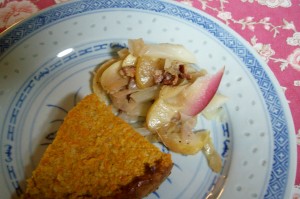 Choux aux Pommes (Cabbage and Apples)
Choux aux Pommes (Cabbage and Apples)
1 head white cabbage
2 lbs. apples, unpeeled, sliced
1 qt. salted water
5 strips bacon, diced
½ tsp. salt
¼ tsp. pepper
½ tsp. grated nutmeg
Shred cabbage and blanch in salted water. Place alternative layers of apples and cabbage in a greased kettle. Fry bacon in another kettle and add it, with grease, to apple/cabbage mixture. Add seasonings, cover, and simmer 2 hours.
History from the Hearth, A Colonial Michilimackinac Cookbook by Sally Eustice
Baked Carrot Pudding
2 cups grated carrots
1 onion, chopped
1 cup water
Bring everything to a boil and cook 5 minutes.* Mash or whip until smooth. Add the following ingredients:
1 egg, beaten
1 T butter
½ cup milk
½ cup dry bread crumbs
¼ tsp cinnamon
Place in a crock and place on a trivet in a Dutch oven. Bake covered for 20 minutes.*
History from the Hearth, A Colonial Michilimackinac Cookbook by Sally Eustice
* Note: Boil carrots and onions 10 minutes until soft. And if baking pudding directly in an oven, oven temperature should be 350 degrees and bake approximately 1 hour.
An additional recipe:
Carrot Puding
Take a large Carrot, boil it Tender then set it by to be cold and grate it through a hair sieve very fine, then put in half a pound of melted Butter beaten with Eight Eggs leaving out half the Whites, two or three Spoonfulls of Sack and Orange flower Water, half a pint of good thick cream, a little grated Bread, a Nutmeg and a little salt, sweeten it to your tast, and make it the thickness of an Orange Pudding.
The Receipt Book of Harriott Pinckney Horry, 1770 (CK-text copied as printed)
Excerpt from the article “The Material Culture and Daily Lives of Women in Colonial Vincennes” by Denice Wilson published in Selections from LeJournal 1983-2005, French Colonial Studies: Le Pays des Illinois. Center for French Colonial Studies, Extended Publications Series, Number 6. Margaret Kimball Brown, H. Randolph Williams, Editors.
“In the gardens, situated next to their houses, women cultivated a wide variety of vegetables for use in their kitchens. The small orchards near the house provided apples, peaches, pears, and cherries. According to the English traveler John Bradbury, the French paid great attention to their gardening, and the apples and peaches were particularly fine…
Travelers to the Illinois Country were impressed with the way French women prepared meat dishes. Wild game and domestic hogs, cattle, and chicken were boiled, roasted, fricasseed, or stewed. Smoked hams were a regional specialty, and those not needed for Local consumption were shipped down river to New Orleans. No meal was complete without the popular bread slices topped with raw onions. ”
March 30, 3rd Annual School Day Event At Fort de Chartres,
Sponsored by Save Illinois History
Submitted by Renea Davis, Antoinette Hancock, and Carol Kuntz
Renea Davis
Butter Drops Four yolks, two whites, one pound of flour, a quarter pound butter, one pound sugar, two tablespoons of rosewater, a little mace. Amelia Simmons American Cookery p 38
Additions: Make the batter thicker with flour and sugar if you want to make cookies or thinner with more butter if you want to make a cake.
To make Lemon Puffs
1 1/4 pound of double-refin’d sugar beaten and sifted. Grate the rinds of four lemons. Mix the rinds well with the sugar. Then beat the whites of three new laid eggs very well. Mix it well with your sugar and lemon peel. Beat the mixture together an hour and quarter (I thought I would beat it until it is well mixed together. A mixer can be used also.) Make it up in what form you please; be quick to set them in a moderate oven; don’t take them off the papers till cold.
Antoinette Hancock
Common biscuits
Beat 8 eggs half an hour (if using a whisk). Put in a pound of sugar beat and sifted with the rind of a lemon grated. Beat them well together for one hour (if doing this by hand). Then put in a pound of flour with a little rosewater. Bake them in tins or on paper (parchment) with sugar over them.
Elizabeth Raffald’s The Experienced English Housekeeper, 1769 (with a few minor adjustments/suggestions)
Wigs
To 3/4 of a pound of flour put half a pint of milk made warm.
Mix in 2 or 3 spoonful’s of light barm ( 1 package yeast will do).
Cover it up and set it by the fire to rise.
Work into the paste 4 ounces of sugar and 4 ounces of butter.
Make the dough into wigs with as little flour as possible and a few seeds.
(Work in some seeds (caraway or coriander) and add enough flour to dough so you can roll out and cut into whatever shape as you please – triangles were popular).
Let rise and set in a quick oven to bake.
(These do not take long to bake in a 350 oven – when browned, they are done.)
Elizabeth Raffald (with a few minor adjustments/suggestions)
A Common seed cake
Take 2 pounds of flour, rub into it 1/2 pound of powder sugar (I use brown sugar) and add some seeds (caraway or coriander or fennel, as you please).
Have ready a pint of mild with 1/2 pound of butter melted in it and 2 teaspoons new barm (2 packages yeast will do).
Make it up into a paste ( a sticky dough that I divide into 2 pieces) and set it by the fire to rise.
Flour a tin (a container to hold it) Or shape into a round loaf and bake in a quick oven until done.
Elizabeth Raffald (with a few minor adjustments/suggestions)
Comfits These are seeds that have been covered with several layers of sugar syrup and allowed to dry after each application. They are the breath mint of the 18th century, often served with wine after a meal.
My method is simple but time consuming. Slowly dissolve 1 cup sugar in 1/3 cup water and bring to near candy stage. The syrup is thick and will begin to thread when poured slowly from a spoon.
Have your seeds ready in a small metal bowl.
Pour a tablespoon of sugar syrup over the seeds and immediately stir them up with a fork or wooden spoon quickly trying to coat each seed (which to my mind is impossible).
When cooled a bit, I put the seed clump onto a cookie sheet so I can break up the clump into individual seeds with my hands – rolling the seeds around to separate them.
Repeat this process as many times as you like. My limit is in the 5 to 10 range.
Ivan Day: http://www.historicfood.com/Comfits.htm
Other methods: http://www.gallowglass.org/jadwiga/SCA/cooking/recipes/Comfits.htm
Sugared Peel
Remove the peel from lemons/limes/grapefruits/oranges with as little of the pith as possible.
Place the peels in water in the refrigerator.
Change the water every day for 5 days.
Drain the peels and place in a pan of sugar syrup (1 cup sugar dissolved in 1 cup water).
Boil the the peels gently for 1/2 hour.
Allow to cool and place in the refrigerator overnight.
For another 1-2 days, repeat.
Drain the peels sift, sugar over them and allow to dry.
http://damealys.medievalcookery.com/CandiedFruitPeel.html
Carol Kuntz
Colonial Apple Cake Recipe found in an 18th century farmhouse in Vermont. It was discovered in an old cookery manuscript in the attic. Among the recipes was one for apple cake, which they adapted to modern cooking methods. You can make this in a Dutch oven or bake in oven.
½ cup shortening
2 cups sugar
2 eggs
2 cups flour
½ tsp nutmeg
1 tsp cinnamon
1 tsp soda (18th c – pearl ash)
1 tsp salt
6 apples, diced
1 cup raisins
Cream together the shortening and sugar. Mix in the eggs. Add the dry ingredients to the creamed mixture, stirring well. Fold in the apples and raisins. Bake at 350F for 35-50 minutes until center is done. CK
Corn Bread Receipt
1 pint of Indian (corn) meal
½ pint of wheat flour
1 tsp cream of tartar
A pinch of salt
Add:
1 pint of milk
2 eggs well beaten
½ teaspoon pearl ash (baking soda)
¼ cup butter
In bowl, stir together cornmeal, flour, cream of tartar, salt and ash (or soda). Combine eggs, milk, and butter. Add to dry ingredients. Mix well. Turn into greased baking pan. Bake in quick oven (375-400 degree F) for 20 minutes or until done. Adapted from Receipts from the Days of Old Kaskaskia.
French Sablés According to the “letters” of the Marquise de Sévigné, the biscuit was created for the first time in Sablé-sur-Sarthe in 1670.
Sables, also known as a French Butter Cookie or Breton Biscuit, is a classic French cookie originating in Normandy France. The name ‘Sables’ is French for “sand”, which refers to the sandy texture of this delicate and crumbly shortbread-like cookie. The traditional shape is round with fluted edges and the tops of the cookies are usually brushed with an egg wash to give them a shiny appearance. The finishing touch, which makes them instantly recognizable, is to score a criss-cross pattern on the top of each cookie.
1 cup flour
1/3 cup unsalted butter
4 Tablespoons sugar
1 egg yolk
1 Tablespoon water
Preheat oven to 400 degrees.
Place flour butter and 2 Tablespoons of sugar in a bowl and combine In a small bowl combine the egg yolk and water.
Add the egg mixture to the flour mixture. Mix another 5 to 10 seconds, or until the dough forms a ball. (at this point the dough can be wrapped and refrigerated for up to 3 days before baking.)
To bake:
Roll out the sablé dough on a floured surface to a ¼-inch thickness. Cut the dough into 3-inch rounds using a round form or cut into squares using a ruler and pastry wheel or knife. (This should yield at least 8 cookies.)
Arrange the cut-outs on an ungreased baking sheet. Sprinkle them with the remaining 2 Tablespoons of sugar. Bake at 400 degrees for 12 – 15 minutes or until very lightly browned. Remove from oven and cool on a wire rack.
Shrewsbury Cakes Half pound butter, three quarters of a pound sugar, a little mace, four eggs mixed and beat with your hand, till very light, put the composition to one pound flour, roll into small cakes—bake with a light oven.
N.B. In all cases where spices are named, it is supposed that they be pounded fine and sifted; sugar must be dried in an oven; eggs well beat or whipped into a raging foam.
Amelia Simmons, American Cookery (1796) a var. E. Smith, The Compleat Housewife, 1742
Modern Shrewsbury Cakes
½ cup sugar
½ cup butter
1 egg, beaten
2 cups flour
1 tsp mace
Grease baking sheets. Cream the butter and sugar until pale and fluffy. Add egg and stir well. Sift flour and spice into creamed mixture and stir. Turn dough onto floured surface and knead a few times. Dough should be crumbly, Roll dough out into ¼ “thickness. Cut into 2” rounds or whatever size you desire. Place on greased sheets . Bake at 350 degrees for 10-12 minutes or until bottoms or cookies are lightly browned. Makes 3 dozen cookies. Add the egg yolks and beat well.
Novembre
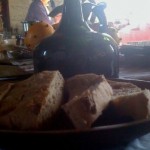 Roasted Turkey and Turkey Stewed in an Onion Sauce
Roasted Turkey and Turkey Stewed in an Onion Sauce
Among the many ways to prepare turkey, roasted, stewed, these two here are without doubt the newest and so those of which we should first speak. One is of turkeys stuffed with fines herbes; and the other, in onion sauce.
[WITH FINES HERBES]
Take turkeys and tie them for roasting, without blanching them. Pull away the skin above the stomach in order to stuff them. This stuffing is made of chopped raw lard, parsley, spring onion and all sorts of fines herbes; all of this chopped fine and even crushed a little in the mortar and well seasoned.
Stuff turkeys between the skin and the flesh, and roast them. Once roasted, lay them out on the plate, and put a good ragout over them, made of all sorts of garnishings, and serve hot…. And to disguise them from one day to the next one can put them over hot coals, having stuffed them as above; once cooked, drain them well, and serve them with a good ragout of truffles and sweetbreads, all well strained, the fat skimmed off and covered with small croquets.
[WITH ONION SAUCE (“essence”)]
Cut onions into slices and strain them into a casserole, with lard. Once strained, skim off the fat, put in a pinch of flour, and strain it again together; then add some good gravy, some cloves, and other necessary seasonings.
When everything is a little cooked, strain them properly with the strainer; put it back in a casserole, pour in a trickle of verjus and a coulis of bread.
Your turkeys must be roasted, the wings well tied, on the stomach and the legs. Lay them out in a dish, and pour the sauce over them hot, and serve it neatly.
The Art of Cookery Made Plan and Easy, Hannah Glasse, 1747
When you roast a goose, turkey or fowls of any sort, take care to singe them with a piece of white paper, and paste them with a piece of butter, dredge; dredge them with a little flour, and sprinkle a little salton; and when the smoke begins to draw to the fire, and they look plmp, base them again, and drudge them with a little flour, and take them up.
The Art of Cookery Made Plan and Easy, Hannah Glasse, 1747
Tourtière (French Pork Pie)
2 pounds pork loin, diced into 1/2 inch pieces or ground
1 ¼ tcup chopped onion
2/3 cup water
salt and pepper to taste
1 tsp cinnamon
¾ tsp ground cloves
¾ tsp ground nutmeg
1 Tbl flour
¼ cup cup water
Directions
Combine pork and onion in a skillet and brown. Add water, salt, pepper, cinnamon, cloves and nutmer and simmer for 20 min. Meanwhile stir flour and ¼ cup cold water until there are no lumps. When meat mixture is ready, stir in flour mixture, bring to boil and thicken.
Pease Porridge: Beond the King’s Bread, by JoAnn Demler, Old Fort Niagara Association. 2003 (Note: Cormier –Boudreau & Gallant p. 158
Using Royal Paste No. 9, previously posted in the October Recettes, roll on a well floured surface. Place into pie tin. Add meat mixture. Place top crust on carefully and make ½ inch slits to allow pie to vent. Brush with egg. Bake at 425 degrees for 10 minutes and then lower heat to 350 degrees. Bake 4o minutes or until crust is brown. This may also be served cold and topped with real maple syrup.
More recettes soon to follow celebrating fall ‘s bounty.
Fort de Chartres Winter Rendezvous
Bake Oven Recettes/Receipts
Reflecting French, English and American Occupations
Butter Drops
Four yolks, two whites, one pound of flour, a quarter pound butter, one pound sugar, two tablespoons of rosewater, a little mace.
Amelia Simmons American Cookery p 38
Additions: Make the batter thicker with flour and sugar if you want to make cookies or thinner with more butter if you want to make a cake. RD
Colonial Apple Cake
Recipe found in an 18th century farmhouse in Vermont. It was discovered in an old cookery manuscript in the attic. Among the recipes was one for apple cake, which they adapted to modern cooking methods. You can make this in a Dutch oven or use your regular oven.
½ cup shortening
2 cups sugar
2 eggs
2 cups flour
½ tsp nutmeg
1 tsp cinnamon
1 tsp soda (18th c – pearl ash)
1 tsp salt
6 apples, diced
1 cup raisins
Cream together the shortening and sugar. Mix in the eggs. Add the dry ingredients to the creamed mixture, stirring well. Fold in the apples and raisins. Bake at 350F for 35-50 minutes until center is done. CK
Tea Cakes
1 lb sugar
2 lb flour
3 eggs
1 gill yeast – I will use 1 pkg yeast
a little cinnamon
and orange peel
bake 15 minutes
Amelia Simmons AH
To make Syrup of Citron
Pare and slice you citrons thin, lay them in a bason, with layers of fine sugar. The next day pour off the liquor into a glass, skim it, clarify it over a gentle fire.
p. 209 Art of Cookery Made Plain and Easy by Hannah Glasse. RD
Corn (Hoe) Bread
* 1 cup yellow cornmeal
* 1 cup flour
* 2 teaspoons baking powder
* 3/4 teaspoon salt
* 1/2 teaspoon baking soda
* 2 eggs, beaten
* 1/2 cup milk
* 1/2 cup beer
* 1/4 cup oil
In bowl, stir together cornmeal, flour, baking powder, salt and soda.
Combine eggs, milk, beer and oil. Add to dry ingredients. Mix well.
Turn into greased 8 x 8 x 2 inch baking pan or equal size baking dish.
Bake in 425 degree F oven for 15 minutes or until done.
http://cooking-with-beer.blogspot.com/2006/03/beer-corn-bread.html
Similar cornbread receipts contained in Mary Randolph’s Virginia Housewife and in the Receipts from the Days of Old Kaskaskia. CK
Honey Beer Spice Cake
Ingredients
1/2 c Butter
2 c Sugar
4 Eggs
1/2 c Orange juice*
1/2 c Apple butter
3/4 c Honey
4 c Flour, sifted
2 tsp Baking powder*
1/4 tsp Salt
1 tsp Baking soda*
1 tsp Nutmeg
1 tsp Cloves
1 tsp Cinnamon
1 tsp Allspice
1 c Beer
1 c Raisins, seedless
1/2 c Black walnuts, chopped
Instructions:
Preheat oven to 325F.
Cream butter and sugar til fluffy.
Add eggs, one at a time, beating well after each addition.
Add apple butter, orange juice and honey. Mix together well.
Add sifted dry ingredients alternately with beer, beginning and ending with dry ingredients.
Add raisins and nuts which have been coated with flour.
Pour batter in greased and floured hoop pan (wrap & tied with brown paper). Or greased tube pan.
Bake for 1 hour and 20 min.
Sprinkle top and sides with confectioners sugar to finish.
http://recipeland.com/recipe/v/Honey-Beer-Cake-8041
Note: This recipe above is very similar to many 18th century spice cake recipes. To replicate 18th century baking techniques, the baking powder and soda and Confectioners sugar were omitted. Eggs were separated and the egg whites whipped to firm peaks, 1 tsp of pearl ash used in place of the baking soda. The juice and zest of one orange used in place of orange juice. This cake was baked in an 18th century type 10″ tin hoop.
Philip the Bold, Duke of Burgundy married Marguerite of Flanders in 1369. Her favorite cake was a honey cake however it was not until the 18th century when the cake became popular in Dijon, this is when Dijon became capital of the honey cake. The Burgundian Dukes controlled the oriental spice trade and so they developed a taste for nutmeg, cinnamon, cloves, anise and ginger and hence Spice Bread. Planet Food – Burgundy Recipes, Pain d’Epices
Additional traditional spice cake recipe: Spice Cake, Receipts from the Days of Old Kaskaskia. CK
Honey Cake
Six pound flour, 2 pounds honey, 1 pound sugar, 2 ounces cinnamon, 1 ounce ginger, a little orange peel, 2 teaspoons pearl-ash, 6 eggs; dissolve pearl-ash in milk, put the whole together, moisten with milk if necessary, bake 20 minutes. American Cookery, Ameila Simmons
Renea’s notes: I have substituted baking soda for the pearl ash, separated eggs, whipped the whites, added the yolks and then folded whites into the mixture. I have also used more ginger and less cinnamon and about ½ teaspoon of orange peel. The “moisten with milk” is definitely necessary. Add until a little thicker than a modern cake recipe (at least 1 ½ cups of milk). RD
Original Mince-Pies Recipe From Hannah Glasse, ‘The Art Of Cookery’, Published 1740
To make mince-pies the best way.
Take three pounds of suet shred very fine, and chopped as small as possible; two pounds of raisins stoned, and chopped as fine as possible; two pounds of currants nicely picked, washed, rubbed, and dried at the fire; half a hundred of fine pipins, pared, cored and chopped small; half a pound of sugar pounded fine; a quarter an ounce, of mace, a quarter of an ounce of cloves, two large nutmegs, all beat fine; put all together into a great pan, and mix it well together with half a pint of brandy, and half a pint of sack [wine]; put it down close in a stone pot, and it will keep good for four months.
When you make your pies, take a little dish, something bigger than a soup plate, lay a very thin crust all over it, lay a thin layer of meat, and then a thin layer of citron cut very thin, then a layer of mince meat, and a layer of orange-peel cut thin, over that a little meat, squeeze half the juice of a fine Seville orange or lemon, lay on your crust and bake it nicely.*
These pies eat finely cold. If you make them in little patties, mix your meat and sweetmeats accordingly. If you chuse meat in your pies, parboil a neat’s tongue, peel it, and chop the meat as fine as possible, and mix with the rest; or two pounds of the inside of a sirloin of beef boiled. But you must double the quantity of fruit when you use meat.
*Mince-pies must be baked in tin patties, because taking them out, and puff-paste is best for them.
From Hannah Glasse, ‘The Art Of Cookery’, Published 1740
Adapted Make Your Own Mincemeat (From an 18th Century Recipe)
Yield: 4 quarts
About This Recipe
1 lb round ground beef
water
5 cups firmly packed shredded peeled apples
1/3 cup diced candied lemon peel
1/3 cup diced candied orange peel
1/3 cup citron melon preserves
1 lb raisins (seeded or seedless)
½ lb. golden raisins
½ lb dried currants
1 large oranges, juice and rind of, grated
1 lemons, juice and rind of, grated
1/2 lb finely ground beef suet, all skin removed
3 1/2 cups dark brown sugar
1 1/2 teaspoons salt
1 teaspoon ground allspice
1 teaspoon ea. cinnamon, cloves
1 ½ teaspoon mace
¼ teaspoon nutmeg
3/4 brandy
1/4 cup rum
Directions
Simmer beef in 2 c water, covered for about 10 minutes.
Put beef and broth in large kettle and add all other ingredients except liquors.
Let come to a hard boil.
Then turn down heat low and simmer for about 5 minutes, stirring to keep from sticking and to assure even distribution of spices and fat through the mixture.
Let cool.
Then add spirits.
Place in jars or a single gallon jar and store in a cool dark place for 3 weeks before using.
Frozen it will keep up to 6 months.
For Pie:.
Fill pastry-lined pie pan with mincemeat.
Adjust top crust or lattice top, and bake in preheated hot oven (425) for 30 minutes. CK
To make Pompion Chips
Shave your Pompion thin with a plain and cut it in slips about the width of your finger, put shreds of Lemon peal among it, wet your sugar with orange Juice and boil it into Syrup. Then put in your chips and lemon Peal and let them boil till done.
The Receipt Book of Harriott Pinckney Horry, 1770 CK
Pumpkin Pie
Take the Pumpkin and peel the rind off, then stew it till it is quite soft, and put thereto one pint of pumpkin, one pint of milk, one glass of malaga wine, one glass or rose-water, it you like it, seven eggs half a poind of fresh butter, one small nutmeg, and sugar and salt to your taste.
p.158 Art of Cookery Made Plain and Easy by Hannah Glasse. RD
To make Cranberry Tarts
To one pound of flour three quarters of a pound of butter, then stew your cranberry’s to a jelly, putting good brown sugar in to sweeten them, strain the cranberry’s and then put them in your patty pans for baking in a moderate oven for half an hour.
p.158-159 Art of Cookery Made Plain and Easy by Hannah Glasse RD
Prairie du Rocher Yeast Cakes and Bread Recette contained in the Recettes of old Prairie du Rocher, Randolph County Historical Society. Copies of this 1973 publication available for purchase at the Fort de Chartres Store, http://www.fortdechartresstore.com/fortdechartresstore.html
Also available at the Randolph County Historical Society. CK
Royal Paste No. 9
Rub half a pound of butter into one pound of flour, four whites beat to a foam, two ounces of fine sugar; roll often, rubbing one third, and rolling two thirds of the butter is best; excellent for tarts. American Cookery, Ameila Simmons RD
Sally Lunn
Plimouth Colony Cook Book
1 yeast cake dissolved in 2 cups lukewarm milk
Add 1 cup brown sugar
2 Tablespoons melted butter
And 5 eggs well beaten
Add ~5 cups flour to make the dough
Let rise to double in bulk
I will make into rolls
Bake in a hot oven (400) for about 20 minutes.
Plimouth Colony Cook Book AH
To make a common seed cake
Take 2 lbs flour
Rub into it 1/2 lb sugar
And some carraway or coriander seeds
Melt 1/2 lb butter in 1 pint milk
Add 2 spoonfuls of new barm – I will use 2 pkgs yeas
Make it up quick into a paste and set in a warm place to rise.
Flour your tin and bake it in a quick oven
I never use a tin. Just place it as a round of bread on a baking sheet.
Elizabeth Raffald AH
Spiced Pecans or Walnuts
1 ½ cups pecans or walnut halves
½ white or brown sugar
¼ cup water
½ tablespoon grated orange rind
¼ teaspoon cinnamon
1/8 teaspoon ginger
1/8 tablespoon
Pinch of nutmeg
Combine all ingredients in a heavy skillet.
Heat over mediem temperature until the liquid boils.
Stir constantly until all liquids have evaporated and nuts are coated with sugar.
Spead on platter, separating nuts and allowing them to cool.
Similar recettes for spiced and sugared nuts contained in the Recettes of old Prairie du Rocher, Randolph County Historical Society, Receipts from the Days of Old Kaskaskia and Recipes of Old Saint Genevieve. CK
Wiggs
3/4 pound flour
1/2 pint warm milk
1/4 cup melted butter
(I have seen recipes where the butter is added to the milk at this point – and also where it is kneaded in after the first rise.
Both methods seem to work. Melting the butter and adding at this point is a little less messy.)
2-3 teaspoons of light barm (again – 1 package of 21st century yeast will do)
Mix yeast into milk and melted butter and add flour.
Add 1/2 teaspoon salt
Add 1 beaten egg
Add 4 oz sugar
Add 1/4 nutmeg or allspice as you please
You may add caraway or coriander seeds (I like coriander)
You may add currants as well or instead of seeds.
Mix the ingredients and knead the dough.
Set in a warm place to rise (double in bulk).
Punch down. Lightly knead and roll out the dough. Add flour if dough is too sticky to roll.
Cut into shapes and place on a baking sheet. Triangles seem to be a common shape.
Let them rise in a warm place.
Bake in a quick oven until lightly browned.
350 works well. At a higher temp, they get too brown too quick.
Found in many a period cookbook. One site claimed they were served with cheese and ale. (And they are quite tasty that way!) AH
Renea Davis (RD), Antoinette Hancock (AH), Carol Kuntz (CK)
Bake Oven Savory Recettes/Receipts
French, Native, and American Recipes
Minnetaree (Hidatsa) Pumpkin
1 4- to 5-pound sugar pumpkin
2 teaspoons salt
½ teaspoon dry mustard
1 to 2 tablespoons vegetable oil or rendered fat
1 pound ground venison, buffalo, or lean beef
1 medium onion, chopped
1 cup wild rice, cooked (or brown and wild rice)
3 eggs, beaten (or egg beaters or egg whites)
1 teaspoon crushed dried sage (the cooking kind)
¼ teaspoon pepper
Preheat oven to 350 F. Cut the top from pumpkin (like you would for a jack o’lantern) and remove seeds and strings from cavity. Prick cavity with a fork all over and rub with 1 teaspoon of salt and the dry mustard. Heat oil in large skillet. Add meat and onion and sauté over medium-high heat until browned. Off the heat, stir in wild rice, eggs, remaining salt, sage, and pepper. Stuff pumpkin with this mixture. Place ½ inch of water in the bottom of a shallow baking pan.
Put pumpkin (and the lid) in the pan and bake for 1 ½ hours, or until tender. Add more water to the pan as necessary to avoid sticking. When done, bring to table with lid askew on top of pumpkin at a jaunty angle-it looks really nice. Cut pumpkin into wedges, giving each person both pumpkin and stuffing. ( The skin is tough and bitter and should not be eaten, but the flesh of the pumpkin will scrape away easily.)
This would also make a good vegetarian recipe by leaving out the meat. It can be rather bland, however, and you may wish to add additional seasoning and cook your rice in a vegetable broth or stock instead of water. The pumpkin seeds you pulled out can be toasted for a snack. CK
Sucrine du Berry Squash Velvet Soup
Ingredients
1. 4 cups of chopped Sucrine du Barry squash
2. 4 leeks cleaned and chopped (remove only the tough green part, both white and green parts can be used)
3. 1/4 onion sliced
4. 3 tsp of butter or olive oil
5. 2 tsp of black pepper (adjust to taste)
6. 1 tsp of red chili powder (optional)
7. salt to taste
8. 3 cups of low sodium chicken stock (substitute with water for a vegetarian version)
9. sour cream for garnish
10. almonds or pistachios for garnish
Method
1. In a thick bottom pan, heat the butter, add the onions and leeks and let them saute for a few minutes.
2. Add the squash, 1 tsp of pepper and saute for a minute more.
3. Now add the chicken stock, close the lid and cook for 10-15 minutes till the squash is soft.
4. add salt, the chili powder and remaining pepper powder, taste and let boil for a minute more.
5. Let cool and blend in a blender or using a hand held blender
6. Serve with a dollop of sour cream and crushed nuts on top.
The sweetness from the squash and the slightly pungent taste from the leeks along with the creamy sour cream made for a delicious soup.
Jacques Pepin CK
Sucrine Du Berry(C. moschata) A famous, old, traditional variety from the heart of France. It has a sweet, musky fragrance and a delicious, sweet flesh that is used in jams, soups, and many French recipes. Small 3-5 lb. fruit are perfect for roasting and have deep orange flesh. Oblong, bell-shaped fruit are tannish-orange in color
Berrichon Squash Pastry
Adapted from The Compleat Squash by Amy Goldman (Artisan)
Flour, for board
2 frozen puff pastry sheets, thawed
3 cups minced raw winter squash, preferably Sucrine du Berry, turban or butternut
1 small onion, minced
1/2 cup chopped flat-leaf parsley leaves
Salt and freshly ground black pepper
1 egg, beaten
1/2 cup crème fraiche, optional.
1. Heat oven to 400 degrees. Lightly flour a work surface. Divide each pastry sheet in half, and place 2 half-sheets on floured board. Mound squash on each, leaving a 1/2-inch border. Top with onion and parsley. Season with salt and pepper.
2. Use rolling pin to flatten and enlarge remaining half-sheets slightly. Place over filling, and seal by brushing with water and pressing together. Cut three slits in each pasty and brush with egg.
3. Transfer to a baking sheet, and bake until golden, about 30 minutes. Serve warm in slices, with crème fraîche if desired.
Yield: 4 to 8 servings. CK
D’Automne Recettes for the October Heirloom Jardin Produce Saturday
22 October, 2011
The focus of our fall jardin is our root crops: beets, radishes, turnips. Due to the searing heat late summer and early fall in the Illinois country, we have very few carrots to harvest and no cabbages at all. French habitants depended on their fall crops for sustenance through the cold winter months ahead. The benefit to the French colonists in growing these types of vegetables was the ability of root crops to be stored for long periods of time. Happily we also have leeks, lettuce, and spinach to harvest and a few winter squashes.
“The Kitchen herbs, succeed very well here. The white cabbage is very fine, but sometimes suffers greatly from worms. Onions (Allium cep) are very much in use here, together with other species of leeks. They likewise plant several species of gourds, melons, salads, wild succory or wild endives (Cichorium Intybus), several kinds of peas, beans, French beans, carrots and cucumbers. They have plenty of red beets, horseradishes and common radishes, thyme and marjoram.”
“Turnips are found in abundance, and used chiefly in winter. Parsnips are sometimes eaten, though not very common. Few people took notice of potatoes; and neither the common (Solanum tuberous) nor the Bermuda ones (Convolvulus Batatas) were planted in Canada. When the French were asked why they do not plant potatoes, they answer that they cannot find any relish in them, and they laugh at the English who are so fond of them.”
From Peter Kalm’s Travels into North America, Page 119, Volume 3, in Quebec City (population 8,000 in 1750)
Beets
To Fry Beets
The beets are first baked in an oven and peeled, then sliced “long ways and about half an Inch thick”. A batter is prepared with White-wine, flour, cream, more yolks than whites of eggs; and seasoned with salt, pepper and cloves. The sliced beets “lie in the Batter a littel while” and then covered with a mixture of bread crumbs, shredded parsley and flour.
A traditional way to prepare beets in the 18th century was to pickle them. The following recipe is taken from Hannah Glasse’s, The Art of Cookery made Plain and Easy. 1747
To pickle Beet-root
Set a pot of spring water on the fire, when it boils put in your beets, and let them boil til they are tender; take them out, and with a knife take off all the outside, cut them in pieces according to your fancy; put them in a jar, and cover them with cold vinegar, and tie them down close; when you use the beet take it out of the pickle, and cut it into what shape you like; put it in a little dish with some of the pickle over it. You may use it for salads, or garnish.
Leeks
Flamiche aux Poireaux
2 round, puff-pastry crusts, uncooked
3 tablespoons butter
2 pounds (or more) leeks, cleaned and cut into 1/4 inch rounds (don’t use the tougher dark green part)
3 tablespoons flour
2 cups milk
1/4 cup grated gruyère or similar cheese (optional)
salt and pepper
1/8 teaspoon nutmeg
1 egg yolk
Melt the butter in a frying pan on medium heat. Add the leeks and cook until soft – about 10 minutes.
Stir in the flour until mixed completely with the leeks. Pour in the milk and cook, stirring occasionally until the mixture thickens and comes to a boil – about 5 minutes. Remove from heat and let cool about 5 minutes. Stir in nutmeg and salt and pepper to taste.
Meanwhile, line a 9 inch tart or pie pan with one of the crusts. Brush the bottom of the crust with the egg yolk mixed with a couple of teaspoons of water. Pour the cooled leek mixture into the crust and top with the second crust. Roll the edges together so that the whole tart is sealed. Make a hole in the center of the tart so that steam can escape as the tart is cooking and, if you wish, make a design on the top crust with a sharp knife.
Bake for 30 minutes at 375° F. Serve warm. Makes 6 servings.
Adapted from an 18th century recipe from northern France.
Easy French Food http://easy-french-food.com
Bouillon Ordinaire
4 lbs. beef
1 boiling fowl (chicken)
2 onions
3 leeks
1 oz.parsley
1 whole clove
Salt to taste
In a large kettle, add one gallon water to the beef and chicken. Slowly bring to a gentle boil. Skim the foam as it cooks. When no more appears, add the onions with a clove stuck in them, leeks, and parsley. Gently simmer. Remove chicken when it is done. By the time the beef is done so is the bouillon. This will take about five hours. Strain and cool. Discard the fat that solidified on top. This is a good soup but is intended to serve as a broth to many other dishes. Game, birds, and red meat may all be cooked in this bouillon.
Wheaton, Barbara Ketcham, Savouring the Past: The French Kitchen and Table from 1300-1789.
Lettuce
To Make a Lettuce Tart
4 heads lettuce
1 ½ dozen large prunes
Sugar
Salt Cinnamon
Ginger
Butter
Marrow Pastry
Line a deep pie dish with pastry. Dot over with bits of butter, and sprinkle with sugar. A little cinnamon, and ginger. Cook lettuce in boiling salted water until tender. Drain and lay in pastry. On top of this, lay the prunes, which have been soaked, pitted and cooked until tender. Dot over with cubes of marrow, a little sugar, and cinnamon. Cover with the upper crust and bake about three quarters of an hour.
Martha Washington Cook Book
Black Spanish Round Radish
A special note about this root vegetable related to the turnip and horseradish family. It has a dull black exterior that covers a white, crisp flesh providing a peppery hot flavor. The intensity of this radish can vary from mildly hot to very pungent and somewhat bitter, depending on the age and size, tasting somewhat like horseradish. Winter radishes tend to have a milder, more delicate peppery flavor, however the Black radish can be very strong and pungent. This radish may be cooked like a turnip, creamed and served as a side dish or sautéed and braised to be served as a vegetable dish. The skin is generally removed prior to preparing.
The black Spanish radish is a throwback to a time when people counted on storing roots to survive the winter. Black Spanish Round Radish (also known as Ramolaccio and D’Inverno Nero Tondo) dates to at least 1824, but has likely been in cultivation for hundreds of years. Many recipes for black radish call for the root to be grated and marinated in salt water to dispel the mustardy bitterness. A traditional method of sampling a fresh black radish is to cut into pieces with a pinch of salt and a swig of beer. Medicinally, these radishes were used to cure gall bladder and liver complaints or as a blood purifier.
Radish Slaw
2-3 black Spanish radishes, scrubbed and grated
3 cups finely shredded cabbage (optional)
1 cup coarsely grated carrots, any color
1/2 cup thinly sliced green or red onion
2 tablespoons fresh lemon juice
1/2 teaspoon sugar
2 tablespoons oil (olive)
2 tablespoons finely chopped fresh parsley or mint leaves
In a bowl toss together radishes, cabbage, carrots, onion, lemon juice, sugar, oil, herb, and then salt and pepper to taste.
Potage of Radishes
After they have been well scrap’d, leave a small bunch of the greens at the end: Then let them be scalded and boil’d in a good broth, with some thickening Liquor. This potage must be dress’d after the same manner as that as Purslain. (When it is ready, and the crusts are well soaked, place crusts in the middle) Francois Massialot, The Court and Country Cook, 1702
Spinach
To make Spinage Toasts
This recipe is tasty yet unusual for the modern palate. The unexpected spinach and apple combination complement each other wonderfully. These toasts might work for an appetizer or a light lunch. It’s great as a side dish with pork, lamb, or even beef.
18th Century
PICK your Spinage well, wash it, blanch it off in boiling Water for a
quarter of an Hour; then strain it out, and squeeze it well from the Water, and mince it very fine, then put it into a Stone-mortar with three or four Spoonfuls of Apples boil’d to a Marmalade; the Yolks of four Eggs boil’d hard, three raw Eggs, and a couple of coarse Biskets soaked in Cream, season’d with Salt and Sugar; beat these well together, then put it into a Dish, and mix with a good Handful of Currans, pick’d and wash’d, and three or four Spoonfuls of melted Butter; then cut handsome Toasts about half an Inch thick, four Inches long, and two broad, and spread your Spinage, &c. on them half an Inch thick; wet it over with the White of an Egg, butter the Bottom of a Mazarine-dish, or Patty-pan; lay your Toasts in, and bake them, they will be done in half an Hour; scrape a little Nutmeg, and squeeze a little Orange on them; serve up half a dozen upon a Plate for a Supper, or second Course.
– Nott, Cooks and Confectioners Dictionary, Art. 138.
21st Century
1 lb. spinach leaves
2 oz. fresh currants, or dried currants plumped in warm water and drained
1 medium sweet apple
4 egg yolks, hard boiled (optional)
2 small sponge cakes (cupcake size)
3 Tbsp. melted butter
2 medium bread rolls (a little smaller than a fist)
1 cup cream (you may substitute skim milk or low-fat cream)
1/8 tsp. salt
2 to 3 egg whites, whipped to a froth
1 and 1/8 Tbsp. sugar
1/8 tsp. ground nutmeg
Juice of 1 medium orange
Preheat oven to 300°F
In a bowl, break up sponge cakes and cover them with cream, salt, and 1/8 Tbsp. sugar. Mix well and set aside.
Boil spinach 4 to 5 minutes. Strain and let cool. Chop into small pieces.
Peel, core, and chop the apple very small. In small pan, mix apple with 1 Tbsp. sugar. Cook over medium heat to make a small amount of apple marmalade. Set aside.
Separate the hard-boiled egg yolks from whites. Mince yolks and set aside. (Use the whites for another purpose.)
When sponge cakes have become mushy, add currants, apple marmalade, chopped spinach, minced egg yolk, and melted butter. Mix very well.
Slice rolls and toast them under the broiler. Spread spinach mixture on top of each slice and place in an oven-safe dish.
Spread frothed egg whites thinly over each spinach-topped toast and bake in 300°F oven for 15 to 20 minutes or until frothed egg whites are golden.
Remove from oven. Sprinkle nutmeg and drizzle orange juice over each toast. Serve.
Turnip
Turnip Pie
Season mutton chops with salt and pepper, reserving the ends of the neck-bones to lay over the turnips which must be cut into small dice, and put on the steaks. Put two or three good spoonfuls of milk in. You may add sliced onion. Cover with a crust.
http://research.cdh.sc.edu/vegetable/vegetable.php?vegName=Turnips American Domestic Cookery, 1823)
“The Expedition of Humphry Clinker” by Tobias Smollett (1771)
“You know we used to vex poor Murray, of Baliol College, by asking’, if there was really no fruit but turnips in Scotland. Sure enough, I have seen turnips make their appearance, not as a dessert, but by way of hors d’oeuvres, or whets, as radishes are served up betwixt more substantial dishes in France and Italy . But it must be observed, that the turnips of this country are as much superior in sweetness, delicacy, and flavour, to those of England, as a musk melon is to the stock of a common cabbage. They are small and conical, of a yellowish colour, with a very thin skin; and, over and above their agreeable taste, are valuable for their antiscorbutic quality.”
http://adambalic.typepad.com/the_art_and_mystery_of_fo/historical_recipes/
To make Turnip-Wine
Take a good many turnips, pare, slice, and put them in a cider-press, and press out all juice very well. To every gallon of juice have three pounds of lump-sugar, have a vessel ready, just big enough to hold the juice, put your sugar into a vessel, and also to every gallon of juice half a pint of brandy. Pour in the juice, and lay something over the bung for a week to see if it works. If it does, you must bung it down until it has done working; then stop it close for three months, and draw it off in another vessel. When it is fine, bottle it off.
Hannah Glasse’s, The Art of Cookery made Plain and Easy. 1747
Pumpkin
“Tourte of pumpkin”
Boile it with good milk, pass it through a straining pan very thick, and mix it with sugar, butter, a little salt and if you will, a few stamped almonds; let all be very thin. Put it in your sheet of paste; bake it. After it is baked, besprinkle it with sugar and serve.”
— The French Cook , Francois Pierre La Varenne [1653], Translated into English in 1653 by I.D.G., Introduced by Philip and Mary Hyman [East Sussex:Southover Press} 2001 (p. 199-200)
[NOTE: the word pumpkin is thought to derive from the old French word pompion, which in turn is derived from the Greek pepon, meaning melon.]
To make Pompion Chips
Shave your Pompion thin with a plain and cut it in slips about the width of your finger, put shreds of Lemon peal among it, wet your sugar with orange Juice and boil it into Syrup. Then put in your chips and lemon Peal and let them boil till done.
The Receipt Book of Harriott Pinckney Horry, 1770
More fall recipes are listed on this page in the earlier recettes posting-Haute Louisiane en Automne
Bake oven recipes from the samples offered at the Save Illinois History Fete at the Fort Brewfest on October 1.
Carol Kuntz
Honey Beer Spice Cake
Prep 15 min, Hoop cake pan (or modern tube pan)
Cooking 1hr 20 min
Total 1 hr 45 min + cooling
Ingredients
- 1/2 c — Butter
- 2 c — Sugar
- 4 — Eggs
- 1/2 c — Orange juice*
- 1/2 c — Apple butter
- 3/4 c — Honey
- 4 c — Flour, sifted
- 2 tsp – Baking powder*
- 1/4 tsp — Salt
- 1 tsp – Baking soda*
- 1 tsp – Nutmeg
- 1 tsp — Cloves
- 1 tsp – Cinnamon
- 1 tsp – Allspice
- 1 c — Beer
- 1 c — Raisins, seedless
- 1/2 c — Black walnuts, chopped
Instructions:
- Preheat oven to 325F.
- Cream butter and sugar til fluffy.
- Add eggs, one at a time, beating well after each addition.
- Add apple butter, orange juice and honey. Mix together well.
- Add sifted dry ingredients alternately with beer, beginning and ending with dry ingredients.
- Add raisins and nuts which have been coated with flour.
- Pour batter in greased and floured hoop pan (wrap & tied with brown paper). Or greased tube pan.
- Bake for 1 hour and 20 min.
- Sprinkle top and sides with confectioners sugar to finish.
http://recipeland.com/recipe/v/Honey-Beer-Cake-8041
* This recipe above is very similar to many 18th century spice cake recipes. To replicate 18th century baking techniques, the baking powder and soda were omitted. Eggs were separated and the egg whites whipped to firm peaks, 1 tsp of pearl ash used in place of the baking soda. The juice and zest of one orange used in place of orange juice. This cake was baked in an 18th century type 10″ tin hoop.
Philip the Bold, Duke of Burgundy married Marguerite of Flanders in 1369. Her favourite cake was a honey cake however it was not until the 18th century when the cake became popular in Dijon, this is when Dijon became capital of the honey cake. The Burgundian Dukes controlled the oriental spice trade and so they developed a taste for nutmeg, cinnamon, cloves, anise and ginger and hence Spice Bread. Planet Food – Burgundy Recipes, Pain d’Epices
Additional traditional spice cake recipe: Spice Cake, Receipts from the Days of Old Kaskaskia.
Prairie du Rocher Bread
Recipe for yeast cakes and bread contained in the Recettes of old Prairie du Rocher,
Randolph County Historical Society. Copies of this 1973 publication available for purchase at the Fort de Chartres Store.
Beer Corn Bread
* 1 cup yellow cornmeal
* 1 cup flour
* 2 teaspoons baking powder
* 3/4 teaspoon salt
* 1/2 teaspoon baking soda
* 2 eggs, beaten
* 1/2 cup milk
* 1/2 cup beer
* 1/4 cup oil
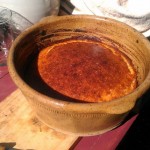 In bowl, stir together cornmeal, flour, baking powder, salt and soda.
In bowl, stir together cornmeal, flour, baking powder, salt and soda.
Combine eggs, milk, beer and oil. Add to dry ingredients. Mix well.
Turn into greased 8 x 8 x 2 inch baking pan or equal size baking dish.
Bake in 425 degree F oven for 15 minutes or until done. http://cooking-with-beer.blogspot.com/2006/03/beer-corn-bread.html
This recipe also was altered to 18th century technique . Eggs were separated and whipped, pearl ash substituted for the omitted baking powder and soda. Many other similar period (non-beer) cornbread receipts exist. A few include: Batter Cakes, Mary Randolph’s Virginia Housewife, Corn Bread Receipts, Receipts from the Days of Old Kaskaskia.
Renea Davis
Honey Cake
Six pound flour, 2 pounds honey, 1 pound sugar, 2 ounces cinnamon, 1 ounce ginger, a little orange peel, 2 teaspoons pearl-ash, 6 eggs; dissolve pearl-ash in milk, put the whole together, moisten with milk if necessary, bake 20 minutes. American Cookery, Ameila Simmons
Renea’s notes: I have substituted baking soda for the pearl ash, separated eggs, whipped the whites, added the yolks and then folded whites into the mixture. I have also used more ginger and less cinnamon and about ½ teaspoon of orange peel. The “moisten with milk” is definitely necessary. Add until a little thicker than a modern cake recipe (at least 1 ½ cups of milk).
Royal Paste No. 9
Rub half a pound of butter into one pound of flour, four whites beat to a foam, two ounces of fine sugar; roll often, rubbing one third, and rolling two thirds of the butter is best; excellent for tarts. American Cookery, Ameila Simmons
Antoinette Hancock
From Elizabeth Raffald’s The Experienced English Housekeeper
Summer squash was a food staple in the Americas for some eight thousand years before the first European explorers arrived. The name was adapted by the settlers from the Algonquin word askutasquash, meaning “eaten raw.” Pattypans were cultivated widely in those times, and their popularity soon caught on in Europe. In England they became known as custard marrow for their delicate fleshy interior, and in France, patisson panaché. For a period in the seventeenth century, pattypan squash was known as cymling because it resembled the English simnal cake, a fluted cake eaten during Lent.
http://homepage.mac.com/jacobsaariaho/iblog/C18326260/E866711353/index.html
Squash or Cimlin
Gather young squashes, peel, and cut them in two; take out the seeds, and boil them till tender; put them into a colander, drain off the water, and rub them with a wooden spoon through the colander; then put them in a stew pan, with a cup full of cream, a piece of butter, some pepper and salt—stew them, stirring very frequently until dry. This is the most delicate way of preparing squashes.
- The Virginia Housewife or, Methodical Cook by Mary Randolph, 1824
Cymling Fritter
After boiling and running through a colander, mix with an egg, season with salt, pepper, and butter, make into cakes and fry a light brown. Marion Cabell Tyree,
- Housekeeping in Old Virginia (Louisville: John P. Morton, 1879), p. 241.
http://www.carolinagoldricefoundation.org/page7/newsletter/files/category-recipes.html
Modern Recipes
Grilled Patty Pan Squash
4 medium sized patty pan squash
olive oil with onion and garlic powder
Cut squash length wise and remove seeds. Wash throughly in cold water and pat dry.
Pour 1/4 cup olive oil into a cup and add 1/4 tsp garlic and 1/4 tsp onion powder. You can add other spices to the oil if desired.
Note: Rosemary, oregano, sweet marjoram, fresh basil, red pepper flakes, salt and pepper, parsley are good suggestions.
Pre-heat grill. Brush squash on one side with olive oil mixture and place face down on grill.Cover for 6 to 10 minutes then brush top of squash with olive oil, turn over and cover again. Repeat this process until squash is golden brown on both sides.Serve hot with bowl side upwards. Can be sprinkled with cheese of your choice.
- Submitted by: Wade Fifield
Stuffed Pattypan Squash
http://allrecipes.com/Recipe/Stuffed-Pattypan-Squash/Detail.aspx
A delicious recipe to use the abundant squash from the garden. The stuffing is easy and wonderful tasting-bacon, cheese, and bread crumbs.
BASIL From the Dictionary of 18th Century Herb Usage
Chiefly used as flavoring when cooking. Used dried as snuff to relieve headaches and colds. Also used as a strewing herb. Basil is in the mint family, native to Africa, Asia, India and Iran. It was brought from Europe to America in the early 1600s and by 1774 was grown commercially in Virginia. Its clove like flavor made many foods more appetizing. Colonists used this herb, also called St. Josephwort, in salads and soups, especially pea soup. Powered basil leaves were used as a snuff and thought to clear the head.
- http://www.chaddsfordhistory.org/history/herbs.htm
Red Seeded Citron Watermelon
Not your typical watermelon, white flesh is hard and tasteless when raw. Citron has been grown for centuries and used to make preserves, pickles, and “sweetmeats.” This variety has vivid red seeds and a light green rind with dark green stripes. Fruits can be stored for up to a year.
Preserved Red Seeded Citron Watermelon
Pare off the outer skin, cut into halves, remove the seeds, then divide each half into a number of smaller pieces. Put them in a stone jar, add a half-cup of salt to every five pounds of citron. Cover with cold water, and stand aside for five hours ; then drain, and cover with fresh, cold water. Soak two hours, changing the water three or four times. Dissolve a teaspoonful of powdered alum in two quarts of boiling water, add the citron, and bring to boiling point. Drain. Make a syrup from two and a half pounds of granulated sugar and one and a half quarts of boiling water, boil and skim. When perfectly clear, put in the citron and simmer gently until you can pierce it with a straw. When tender, lift the pieces carefully with a skimmer, place them on a large plate, and stand in the sun one
or two hours to harden. Peel the yellow rind from one large lemon, add it to the syrup, then add the juice of two lemons, and a small piece of green ginger-root cut in thin
slices. Boil gently for ten minutes, and stand aside until wanted. When the citron has hardened, put it cold into the jars, bring the syrup again to a boil, and strain it over
the citron. Watermelon rind and pumpkin may be preserved in the same manner.
- GardenWeb recipe online from an 1868 cookbook
Citron Preserves
- Cut the melons in quarters and remove the seeds.Peel, and cut into 1″ cubes.
- Cover with boiling water and cook untill tender. Remove from water and drain.
- For each pound of melon allow three-quarters pound of sugar, 1 lemon, and 1 once of preserved ginger.
- Slice lemon thin, discard seeds; cut ginger into small pieces and cook lemon and ginger in water to cover until lemons are soft. Then add sugar and water, using one-half as much water as sugar.
- Cook all together until syrup is thick. Add citron, let stand over night.
- In the morning, heat and simmer slowly one-half hour. Remove citron from syrup, and put into hot jars. Boil syrup down until thick and pour over the citron. Seal.
To Pickle Cucumbers
Let your cucumbers be small, fresh gathered, and free from spots; make a brine of salt and water strong enough to bear an egg; boil this pickle, skim it well, then pour it upon your cucumbers, and stive them down for a day (24 hours); then strain them out into a cullendor, dry them well with a cloth, and take the best white wine vinegar, with cloves, sliced mace, nutmeg, white pepper corns, long pepper, and races of ginger, (as much as you please) boil them up together, and then clap the cucumbers in, with a few vine leaves, and a little salt. Let them simmer in this pickle till they are green, taking care not to let them: put them into jars, stive them down close, and when cold, tie on a bladder and leather.
- The Frugal Housewife, or, Complete woman cook; Susannah Carter, 1803
Pickled Cucumbers
Young cucumbers
Salt
Water
Fresh egg
Vinegar
Cloves
Mace
Nutmeg
Whole pepper
Ginger
Grape leaves
- Make a pickle of salt and water, strong enough to bear an egg. (Fresh eggs will float in salt water if the brine is strong enough).
2. Boil the salt pickle and pour it over the cucumbers in a bowl.
3. Let the cucumbers sit overnight
4. Strain them, cut into slices and drain or dry on paper towel or dish towel. (You can also leave them whole if they are small.)
5. Boil vinegar with cloves, mace, nutmeg, pepper, and ginger. (Ratio of spices to vinegar is about 1 tsp each spice to 1 cup vinegar.) You may increase the spices and use apple cider vinegar if preferred.
6. Put the cucumbers in the pot with the hot vinegar. (Add some grape leaves if you want to)
7. Let the cucumbers sit in the pot several minutes.
8. Transfer the cucumbers to a jar.
9. Pour the vinegar/spice mixture over the pickles.
10. After they have cooled completely, put the lid on the jar. The longer they sit, the more they will taste like pickles. Eat too soon and they taste like vinegar. Suggested time to sit in brine is at least 48 hours.
11. Enjoy the Pickles
- Adapted from Amelia Simmons, American Cookery, 1796, p. 44
Été
“To Make Salamongundy”
Take two or three Roman or Cabbage Lettice, and when you have washed them clean, swing them pretty dry in a Cloth; then beginning at the open End, cut them cross-ways, as fine as a good big Thread, and lay the Lettices so cut, about an Inch thick all over the Bottom of the Dish. When you have thus garnished your Dish, take a Couple of cold roasted Pullets, or Chickens, and cut the Flesh off the Breasts and Wings into Slices, about three Inches long, a Quarter of an Inch broad, and as thin as a Shilling; lay them upon the Lettice round the End to the Middle of the Dish and the other towards the Brim; then having boned and cut six Anchovies each into eight Pieces, lay them all between each Slice of the Fowls, then cut the lean Meat of the Legs into Dice, and cut a Lemon into small Dice; then mince the Yolks of four Eggs, three or four Anchovies, and a little Parsley, and make a round Heap of these in your Dish, piling it up in the Form of a Sugar-loaf, and garnish it with Onions, as big as the Yolk of Eggs, boiled in a good deal of Water very tender and white. Put the largest of the Onions in the Middle on the Top of the Salamongundy, and lay the rest all round the Brim of the Dish, as thick as you can lay them; then beat some Sallat-Oil up with Vinegar, Salt and Pepper and pour over it all. Garnish with Grapes just scalded, or French beans blanched, or Station [nasturtium] Flowers, and serve it up for a first Course.”
- From Hannah Glasse, The Art of cookery…1747, p. 59-60
Mrs. Glasse’s recipe is very similar to Henry Howard’s 1726 instructions in England‘s Newest Way in all Sorts of Cookery…which suggests veal, pickles, sorrel, spinach, chives, horseradish, and barberries. Still others from Glasse use apples, cucumbers, celery, watercress, pickled red cabbage, and pickled gherkins for vegetables, and pickled herring, cold pork, duck, or pigeons for meat. Mrs. Raffald, The Experienced English Housekeeper…[London, 1775, p. 280-281] endorsed pickled herring and garnishes of butter in a pineapple shape. Dressings were usually oil and vinegar or lemon, and sometimes mustard.
The Salad:
2 heads romaine lettuce
2 breast of cooked skinless chicken, (and/or your choice of cooked duck, veal, or pork)
4 boneless cooked chicken thighs
1 lemon
2-4 hard-boiled eggs
3-4 anchovies
For garnishing and augmenting, your choice of the following:
flat leaf parsley
pearl onions cooked
green beans blanched and frenched
red and green grapes
pickled red cabbage
watercress
spinach
pickled gherkins
edible flowers
Vinaigrette:
1 tbs. prepared mustard
4 tbs. red wine vinegar
1/2 tsp. salt
1/2 tsp. freshly ground pepper
1/2 cup olive oil
Shred the lettuce and lay on a platter. Cut the cold meat in julienne, slice the lemon thinly, dice or slice the eggs. Arrange the meat, lemon, and eggs on the lettuce. Add to the platter your choice of parsley, onions, green beans, grapes, watercress, pickled gherkins and flowers.
Peas
To have them in perfection, they must be quite young, gathered early in the morning, kept in a cool place, and not shelled until they are to be dressed; put salt in the water, and when it boils, put in the peas; boil them quick twenty or thirty minutes, according to their age; just before they are taken up, add a little mint chopped very fine; drain all the water from the peas, put in a bit of butter, and serve them up quite hot.
Pg. 105
Field Peas
THERE are may varieties of these peas; the smaller kind are the most delicate. Haver them young and newly gathered, shell and boil them tender; pour them in a colander to drain; put some lard in a frying pan; when it boils, mash the peas, and fry them in a cake of light brown; put it in the dish with the crust uppermost garnish with thin bits of fried bacon. They are vary nice when fried whole, so that easch pea is distinct from the other; but they must be boiled less, and fried with great care. Plain boiling is a very common way of dressing them.
Pg. 110
- The Virginia Housewife: Or, Methodical Cook. By Mary Randolph, 1824
Pease Soup
Officers’ and Common Faire, French Occupation Fort Niagara, 1729-1756
½ lb.split peas
¼ salt pork
1 meaty ham bone
1 medium onion, diced
½ cup carrots, diced
½ tsp dry mustard
¼ tsp ground savory
3 whole cloves
¾ tsp salt
½ tsp pepper
Cover peas with 4 inches of water. Add other ingredients and bring to a boil. Turn down the heat and let simmer for 2 hours or until peas are cooked.
Cook’s Note: You can substitute bacon or ham or salt pork and frying it along with the onion and 1 ½ cloves of garlic to enhance flavor. Fresh herbs and a bay leave can be added when simmering.
- Pease Porridge: Beyond the King’s Bread by JoAnn Demler, 2003
To Keep Green Pease
To keep green pease till Christmas shell and throw them into boiling water andsalt let them boil five or six minutes drain them then lay a cloth four or five times double and dry them well put them in dry bottles cork and melt wax over them then tie them down with a bladder.
Pg. 14
- Harriet O’Fallon’s Cook Book from January, 1821
Missouri Historical Society
Haute Louisiane en Automne
French Chicken and Bouillon
This soup was a staple in the Illinois country, noted by historians as common throughout the area. Traditionally the broth is served separately in cups and the chicken and vegetables served separately on a large plate.
Place 1 large fat hen (4-5 lbs.) in a big pot. With a small amount of fat, sear chicken on the heat until skin is lightly brown. Remove the chicken from the pot and adding instead 1 large onion (sliced) and one turnip (chopped). Brown vegetables in pot until soft, then return chicken to pot, adding salt and pepper.* Fill with water and cook very slowly until chicken is tender.
* A bouqet garni can be added to the pot. Take stems of parsley, basil, chives, wrap in green leek stems and tie with string and suspend in pot. Remove when soup is ready. Another soup version also adds cabbage, carrots, celery, and a few hot peppers to the pot with the onion and turnip.
Variations of this recipe have been gathered from three regional cookbooks containing handed down recipes (recettes) of the Illinois Country:
- Receipts of Old Kaskaskia, Family Favorites Through Tyme” Kaskaskia In Randolph Country, IL, Tricentennial 1703-2003
- Recettes of old Prairie du Rocher, 1673–1973, A collection of Recipes of the French from old Prairie du Rocher for the Randolph County Historical Society
- Recipes of Old Ste. Genevieve, collect by The Woman’s Club of Ste. Genevieve, 1959
Excerpt from a Turnip soup recipe from the French cookbook, The Court & Country Cook, written by Francois Massialot, 1702:
Potage, with Turneps
After having well scrap’d your Turneps, cut them into round pieces, or long-ways, and fry them with Lard and a little Flower: You may make use of the same Lard, in which your Fowls were fried brown, whether they were Ducks, Teals, green Geese, or others; at least if you would not have them roasted a little on the Spit. So that either Way, all may be put in a Pot together, with good Broth, season’d with Pepper, Salt, and a Faggot of Herbs; adding a brown thickening Liquor, as they are stewing; Thus, having laid your Potage a soaking with the same Broth, let the Fowls and Turneps be neatly dress’d and garnish’d, sometimes with fried Bread, and sometimes with Sausages, Andouillets, or young Bacon boil’d together: Afterwards let some Lemmon-juice and good Gravy be put to them, before they are serv’d up to Table. Some cause the Turneps to be boil’d separately.
Another soup from the same source, this time with Radishes:
Potage of Radishes
After they have been well scrap’d, leave a small Bunch of Greens at the end: Then let them be scalded and boil’d in a good Broth, with some thickening Liquor. This potage must be dressed after the same manner as that of Purslain. (boil’d in Broth with an onion stuck with Cloves, a Carrer, a few Parsips, and a thickening liquor: When it is ready, and the Crusts are well soaked, the Potage may be garnish’d in the usual manner.)
Turnip Slaw
Grate turnips into bowl. Heat in skillet – bacon fryings, sugar, vinegar to taste. Pour over grated turnips.
- Receipts of Old Kaskaskia, Family Favorites Through Tyme” Kaskaskia In Randolph Country, IL, Tricentennial 1703-2003
Ramequins
A piece of refined Cheese may be taken, with a Lump of Butter, as much flower as you can get up between your fingers at twice, three Yolks of Eggs, a little pepper and Lemon-juice. When the whole mixture or Farce* is well pounded together, let it be spread upon a Plate, and Bak’d under the Lid of a Pie-pan, with Fire on the top; taking care not to burn.
* Farces, are usually made of several sorts of Meat and Herbs chopped small and well season’d with spice…
- The Court & Country Cook, written by Francois Massialot, 1702
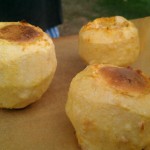
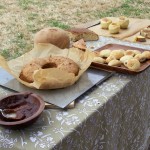
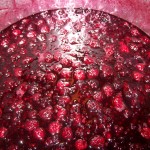
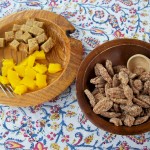
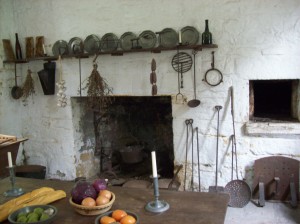
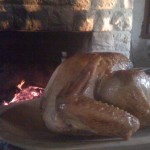
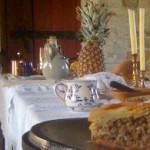
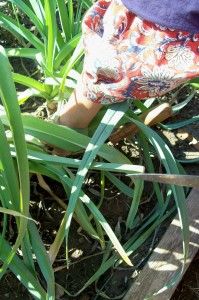
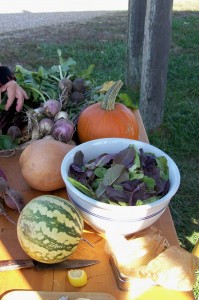
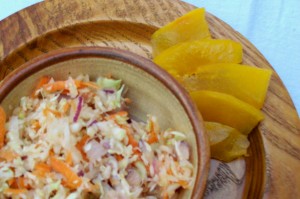
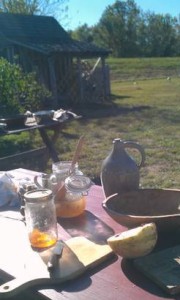
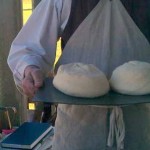
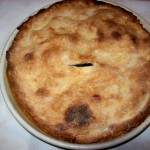

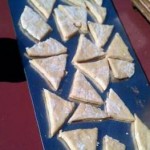
WONDERFUL recipes! thank you so much for sharing! I really enjoyed meeting you and seeing the garden! I look forward to trying some of these recipes and sharing them with my readers as well! Thank you for teaching us about some of the old ways, that we might continue these wonderful lost traditions!
So happy you made the trip to the fort. I really enjoyed speaking with you, as well, and look forward to checking out your blog-http://friedsig.wordpress.com. Wonderful to speak with others who enjoy the process as much as the consuming. Appreciating heirloom produce and exploring the possibilities is an amazing journey.